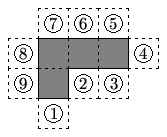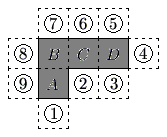Difference between revisions of "2003 AMC 12A Problems/Problem 13"
m |
(→Solution 3) |
||
| (11 intermediate revisions by 9 users not shown) | |||
| Line 1: | Line 1: | ||
| + | {{duplicate|[[2003 AMC 12A Problems|2003 AMC 12A #13]] and [[2003 AMC 10A Problems|2003 AMC 10A #10]]}} | ||
== Problem == | == Problem == | ||
| − | The [[polygon]] enclosed by the solid lines in the figure consists of 4 [[congruent]] [[square (geometry) | squares]] joined [[edge]]-to-edge. One more congruent square is | + | The [[polygon]] enclosed by the solid lines in the figure consists of 4 [[congruent]] [[square (geometry) | squares]] joined [[edge]]-to-edge. One more congruent square is attached to an edge at one of the nine positions indicated. How many of the nine resulting polygons can be folded to form a [[cube (geometry) | cube]] with one face missing? |
[[Image:2003amc10a10.gif]] | [[Image:2003amc10a10.gif]] | ||
| Line 7: | Line 8: | ||
== Solution == | == Solution == | ||
| − | Let the squares be labeled <math>A</math>, <math>B</math>, <math>C</math>, and <math>D</math>. | + | ===Solution 1=== |
| + | [[Image:2003amc10a10solution.gif]] | ||
| + | |||
| + | Let the squares be labeled <math>A</math>, <math>B</math>, <math>C</math>, and <math>D</math>. | ||
When the polygon is folded, the "right" edge of square <math>A</math> becomes adjacent to the "bottom edge" of square <math>C</math>, and the "bottom" edge of square <math>A</math> becomes adjacent to the "bottom" edge of square <math>D</math>. | When the polygon is folded, the "right" edge of square <math>A</math> becomes adjacent to the "bottom edge" of square <math>C</math>, and the "bottom" edge of square <math>A</math> becomes adjacent to the "bottom" edge of square <math>D</math>. | ||
| Line 17: | Line 21: | ||
Squares <math>4</math>, <math>5</math>, <math>6</math>, <math>7</math>, <math>8</math>, and <math>9</math> will allow the polygon to become a cube with one face missing when folded. | Squares <math>4</math>, <math>5</math>, <math>6</math>, <math>7</math>, <math>8</math>, and <math>9</math> will allow the polygon to become a cube with one face missing when folded. | ||
| − | Thus the answer is <math>6 \ | + | Thus the answer is <math>\boxed{\mathrm{(E)}\ 6}</math>. |
| + | |||
| + | ===Solution 2=== | ||
| + | Another way to think of it is that a cube missing one face has <math>5</math> of its <math>6</math> faces. Since the shape has <math>4</math> faces already, we need another face. The only way to add another face is if the added square does not overlap any of the others. <math>1</math>,<math>2</math>, and <math>3</math> overlap, while squares <math>4</math> to <math>9</math> do not. The answer is <math>\boxed{\mathrm{(E)}\ 6}</math> | ||
| + | |||
| + | ===Solution 3=== | ||
| + | If you're good at visualizing, you can imagine each box and fold up the shape into a 3D shape. This solution is only recommended if you are either in a hurry or extremely skilled at visualizing. We find out that <math>4,5,6,7,8</math> and <math>9</math> work. Therefore, the answer is <math>\boxed{\mathrm{(E)}\ 6}</math>. ~Sophia866 | ||
| + | |||
| + | ==Video Solution== | ||
| + | |||
| + | https://www.youtube.com/watch?v=PTA8_vkOekc&t=5s ~David | ||
== See Also == | == See Also == | ||
| − | + | {{AMC10 box|year=2003|ab=A|num-b=9|num-a=11}} | |
| − | + | {{AMC12 box|year=2003|ab=A|num-b=12|num-a=14}} | |
| − | |||
[[Category:Introductory Geometry Problems]] | [[Category:Introductory Geometry Problems]] | ||
| + | {{MAA Notice}} | ||
Latest revision as of 14:43, 19 August 2023
- The following problem is from both the 2003 AMC 12A #13 and 2003 AMC 10A #10, so both problems redirect to this page.
Contents
[hide]Problem
The polygon enclosed by the solid lines in the figure consists of 4 congruent squares joined edge-to-edge. One more congruent square is attached to an edge at one of the nine positions indicated. How many of the nine resulting polygons can be folded to form a cube with one face missing?
![]()
Solution
Solution 1
Let the squares be labeled ![]() ,
, ![]() ,
, ![]() , and
, and ![]() .
.
When the polygon is folded, the "right" edge of square ![]() becomes adjacent to the "bottom edge" of square
becomes adjacent to the "bottom edge" of square ![]() , and the "bottom" edge of square
, and the "bottom" edge of square ![]() becomes adjacent to the "bottom" edge of square
becomes adjacent to the "bottom" edge of square ![]() .
.
So, any "new" square that is attatched to those edges will prevent the polygon from becoming a cube with one face missing.
Therefore, squares ![]() ,
, ![]() , and
, and ![]() will prevent the polygon from becoming a cube with one face missing.
will prevent the polygon from becoming a cube with one face missing.
Squares ![]() ,
, ![]() ,
, ![]() ,
, ![]() ,
, ![]() , and
, and ![]() will allow the polygon to become a cube with one face missing when folded.
will allow the polygon to become a cube with one face missing when folded.
Thus the answer is ![]() .
.
Solution 2
Another way to think of it is that a cube missing one face has ![]() of its
of its ![]() faces. Since the shape has
faces. Since the shape has ![]() faces already, we need another face. The only way to add another face is if the added square does not overlap any of the others.
faces already, we need another face. The only way to add another face is if the added square does not overlap any of the others. ![]() ,
,![]() , and
, and ![]() overlap, while squares
overlap, while squares ![]() to
to ![]() do not. The answer is
do not. The answer is ![]()
Solution 3
If you're good at visualizing, you can imagine each box and fold up the shape into a 3D shape. This solution is only recommended if you are either in a hurry or extremely skilled at visualizing. We find out that ![]() and
and ![]() work. Therefore, the answer is
work. Therefore, the answer is ![]() . ~Sophia866
. ~Sophia866
Video Solution
https://www.youtube.com/watch?v=PTA8_vkOekc&t=5s ~David
See Also
| 2003 AMC 10A (Problems • Answer Key • Resources) | ||
| Preceded by Problem 9 |
Followed by Problem 11 | |
| 1 • 2 • 3 • 4 • 5 • 6 • 7 • 8 • 9 • 10 • 11 • 12 • 13 • 14 • 15 • 16 • 17 • 18 • 19 • 20 • 21 • 22 • 23 • 24 • 25 | ||
| All AMC 10 Problems and Solutions | ||
| 2003 AMC 12A (Problems • Answer Key • Resources) | |
| Preceded by Problem 12 |
Followed by Problem 14 |
| 1 • 2 • 3 • 4 • 5 • 6 • 7 • 8 • 9 • 10 • 11 • 12 • 13 • 14 • 15 • 16 • 17 • 18 • 19 • 20 • 21 • 22 • 23 • 24 • 25 | |
| All AMC 12 Problems and Solutions | |
The problems on this page are copyrighted by the Mathematical Association of America's American Mathematics Competitions. ![]()











